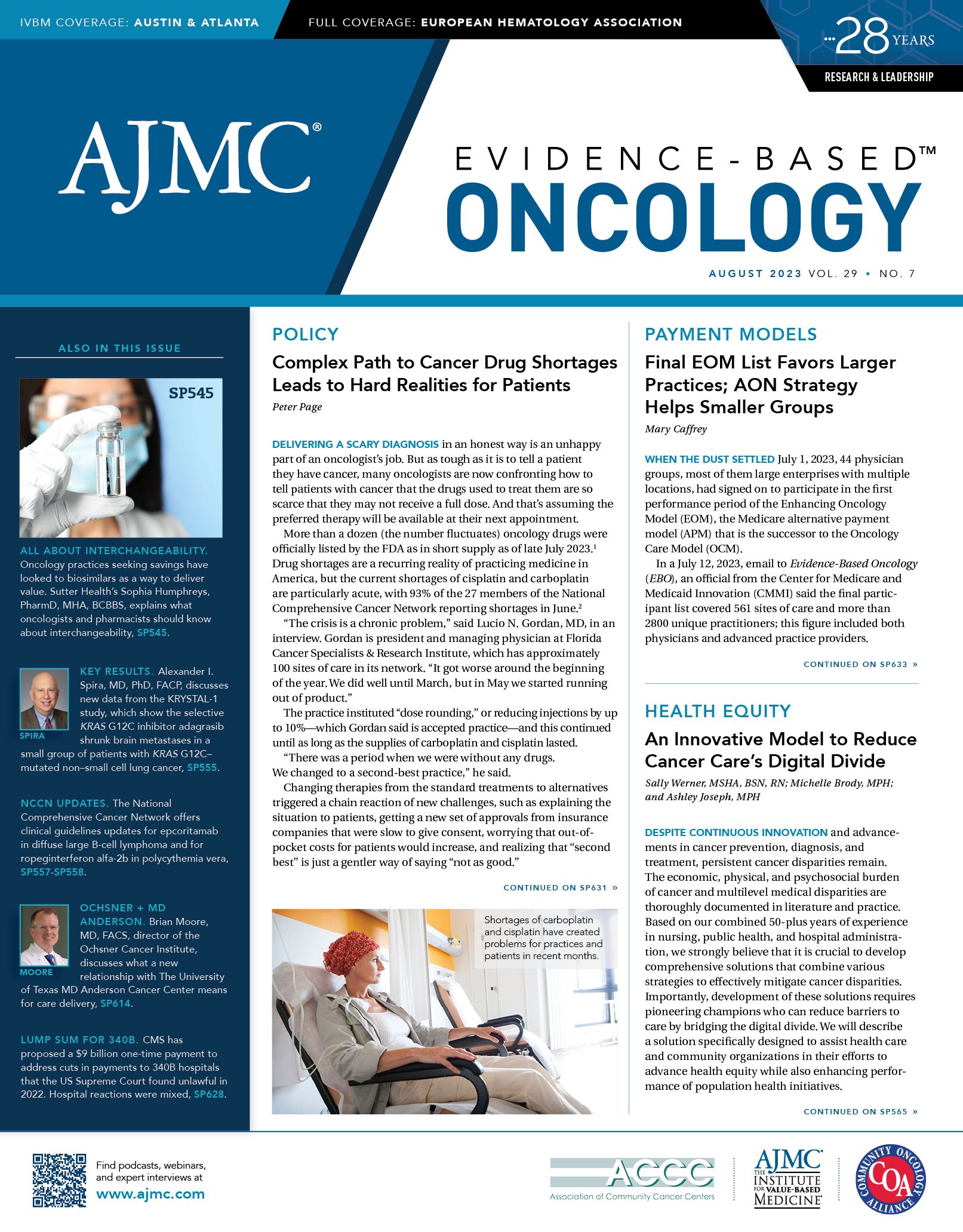Publication
Article
Evidence-Based Oncology
How Does Policy Affect Cancer Care at the Practice Level? Texas Oncology Event Offers Insights
Author(s):
Coverage from the June 8, 2023, Institute for Value-Based Medicine session in Austin, Texas, held in partnership with Texas Oncology.
If you’re an oncologist in a community practice wondering how pharmacy benefit managers (PBMs) get away with things such as white bagging, patient steerage, or excessive prior authorization—and what can be done to stop these things—the June 8, 2023, session of the Institute for Value-Based Medicine® (IVBM), held in Austin, Texas, offered plenty of answers.
Patt
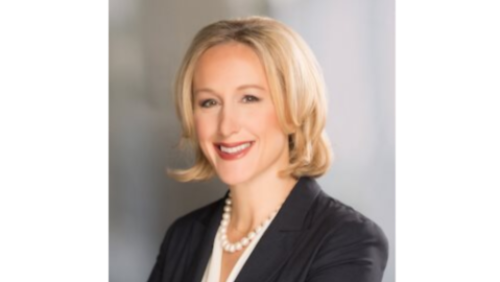
Hosted by Debra Patt, MD, PhD, MBA, a practicing oncologist and executive vice president of Texas Oncology, the session focused on what Patt said are the core elements that make the 250-site practice a leader in value-based care: a host of care management initiatives that “sit on a foundation of optimal communication and education.”
“Only on that good foundation can you build things like symptom control, chronic care management, therapeutic and remote patient monitoring, and even acute care at home,” she said. “It’s been an evolution.”
Texas Oncology’s foundation made the practice a leader in the Oncology Care Model (OCM), Patt said. As the practice looks ahead to the Enhancing Oncology Model (EOM), which started July 1 (see Cover), she described the “levers” that govern value-based care: management of care, treatment of patients, and high-value choices when selecting therapies. From there, Patt introduced experts in patient experience, policy, and care delivery who offered insights in these areas.
In Cancer Care Policy, the Action Is in the States
Jones

Ben Jones, vice president for government relations and public policy for The US Oncology Network, which includes Texas Oncology, moderated an extended policy discussion on how federal and state government actions affect cancer care delivery. Joining Jones were Angela Storseth-Cooper, director of government relations and public policy, The US Oncology Network; Nicolas Ferreyros, managing director for policy, advocacy, and communications, Community Oncology Alliance (COA); and James Lee, senior manager of state regulation and policy, COA.
“This is a really interesting time in cancer care,” Jones said. “We have a whole new outlook on treatment, where we are hopeful that cancer can soon be a chronic condition rather than a death sentence. We’re in the age of immunotherapies that are just completely revolutionizing treatment.”
Practices are also on the “cutting edge of defining value,” Jones said. “But there are a lot of other pressures. And I think that’s what we’re going to start to talk about: How do we navigate some of these pressures to make sure that we’re not losing any progress that we’ve made over the past 10 years?”
With most patients with cancer being older and Medicare eligible, and another 10% being state Medicaid patients, Jones said that government plans cover up to 60% of patient volume and often set the course for commercial plans. “That means it’s very important that the government gets it right,” Jones said.
Yet, since the COVID-19 pandemic, the reimbursement disparities have increased. Jones noted that CMS tried in 2022 to impose an 8% reduction in physician reimbursement, including cuts from the ongoing sequester, just as inflation was climbing at a rate of 11%.1,2 Practices willingly embrace value-based care, he said, but in recent years the numbers just haven’t worked.
Ferreyros agreed, saying CMS added to the competitive imbalance by increasing annual hospital reimbursement rates, alongside payments for 340B drug reimbursement following a US Supreme Court ruling in the hospitals’ favor.3 COA has been arguing for years that these kinds of financial pressures cause community oncology practices to close or accept buyouts from hospitals; suddenly, the same doctors and office can charge patients and insurers more by using a different billing schedule.
Ferreyros
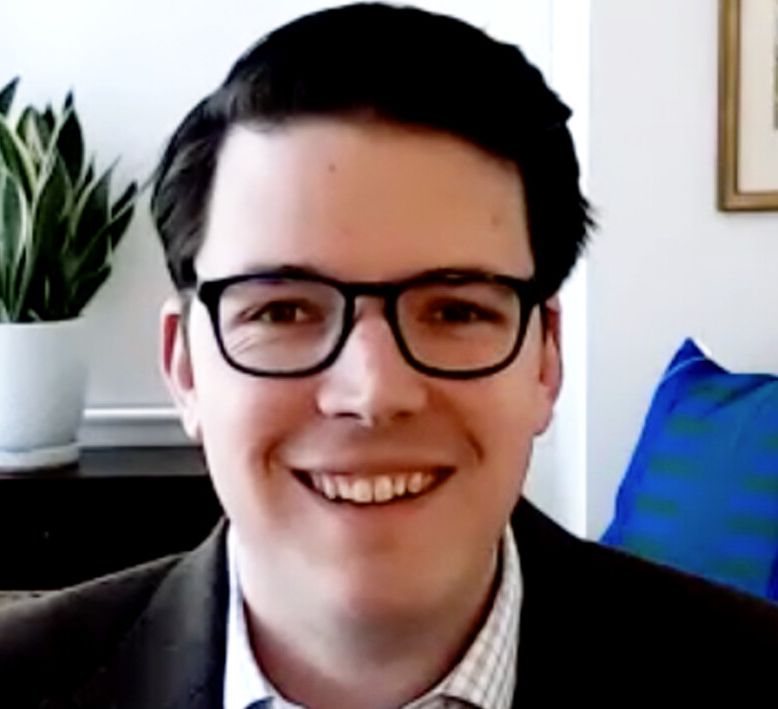
“It’s a highly competitive environment,” said Ferreyros, who estimates that a community oncologist sees 3 to 4 times the patient volume a hospital oncologist sees. “When you talk about the value that community oncology brings to the system, it’s value in quality, affordability. It’s local, it’s accessible, but there’s also value in the fact of just getting patients into the system.”
Jones said that over the past decade efforts at drug pricing reform have been blunt instruments that focus on the government paying less without paying attention to the fallout on community oncology practices, which still rely largely on 6% of drug costs to fund overhead and administrative costs. Those costs don’t change just because the reimbursement drops, Jones said, and since the pandemic, many costs have increased.
“So much of this is driven by what I call bumper sticker politics,” Ferreyros said. The top issue is household health care costs, which Ferreyros said is distinct from health care prices, because costs refer to what individuals pay out of pocket. “What consumers pay at the end of the day—that’s what they really care about,” he said. “And all these issues are sort of chomping away at the side but making good headlines for people in Washington.”
At the time of the Austin meeting, Merck had just announced a lawsuit over the price negotiation tenets of the Inflation Reduction Act (IRA); suits were later filed by Bristol Myers Squibb and the Pharmaceutical Research and Manufacturers of America.4 As Ferreyros noted, elected officials’ desire to rein in health care costs, especially drug costs, won’t stop at the federal level, but will reach the state level.
In state legislatures, Storseth-Cooper said there’s been success at challenging the behavior of PBMs, in both utilization management and in practices such as white bagging and gag clauses. For several years, states did what they could to regulate activities for a limited number of plans, but many employers had plans governed by the Employee Retirement Income Security Act of 1974, and the PBMs also pushed back in court. Then came the case Rutledge v PCMA from Arkansas, which authorized state oversight of PBMs—and in some circumstances over all health plans.5
Storseth-Cooper

With white bagging, Storseth-Cooper said, the PBM mandates that patients receive drugs from their affiliated pharmacy instead of the oncologist’s on-site pharmacy. The prescription may be shipped to the practice, often days after an appointment, which requires the patient to have a separate date for infusion. If a drug is sent in time for the appointment and the oncologist needs to make an adjustment, that drug cannot be used. “It delays care, it adds to drug waste, it can lead to disease progression,” she said.
Rutledge has opened the floodgates for banning this practice, Storseth-Cooper said. Four states have specific language banning white bagging, and 19 have anti-steering legislation that covers the practice. When PBMs argue that the practice saves money, “our message is that it doesn’t save costs for the patient,” Storseth said.
Lee put the work on state legislation in perspective. “We’re talking about policies that are coming from the state level, and what that means for the work that you do and what that means for things that are taking place across the country,” he said. “Let’s say at one of your practice locations you start a pilot program. And then you see the results of that pilot program and you say, ‘Wow, this is really working here. Let’s make sure that we implement this across the practice.’ The same thing is happening when we’re looking at the states and state governments. [They] are really in an experimental phase of trying to figure out what are the best ways to rein in the PBMs.”
Lee
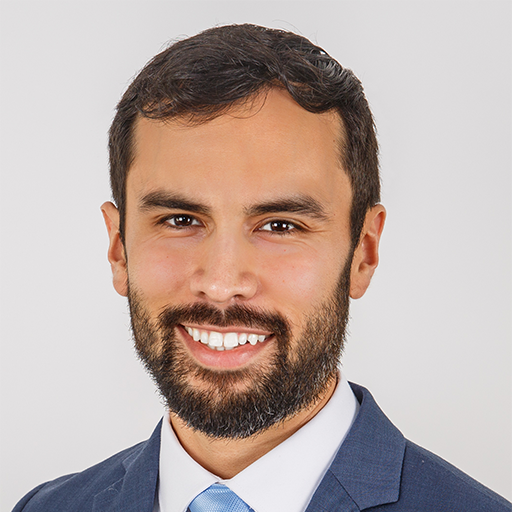
Recent efforts in Florida, Lee explained, were built off prior successes in other states, but received more attention because Governor Ron DeSantis has a higher profile.6
Finally, Ferreyros said, bills in state legislatures have a statistically higher rate of passage than those in Congress. And if enough states act, Congress does pay attention, he said. “The federal government has almost been shamed into playing catch up on a lot of these issues,” Ferreyros said.
During the question-and-answer session, Patt discussed the growing shortage of backbone chemotherapy drugs carboplatin and cisplatin (See Cover), and she also commented on the effects of the IRA on innovation. She drew a connection between the two: “Obviously, policy is all about what happens and then the natural consequences that ensue. And the natural consequence of having erosion of ASP [average sales price] over time in the generic drug industry has caused instability in the supply chain. And so limited manufacturers are investing.”
Could we expect the same dwindling of investment due to the downward pressure on prices caused by the IRA?
Jones said drugs that are selected for price negotiations now have either a 9- or 13-year window of exclusivity before they are eligible for negotiations. “That means as soon as a drug is launched, as soon as that drug is marketed, the clock starts,” he said. If the product gets to the end of the 9- or 13-year window, will it make sense to invest more research dollars into follow-on indications? Probably not, he said.
“Lung cancer and breast cancer are easy, or to move things to the adjuvant setting,” Patt responded. “The incentive to go into smaller diseases that treat a fewer number of patients is gone.” Jones agreed: “It’s gone. And it’s going to evaporate a lot faster than anyone predicted.”
Early projections on the IRA from the Congressional Budget Office estimated that only a few new drugs would not come to market as a result of the law, Jones said, but already there are dozens of drugs affected.7 A report by the group Vital Transformation estimates the drug pipeline could shrink 40% over the next decade.8 “It’s countless. We’ll never know,” Ferreyros said. So many operating models are built on these ASP margins, he said, that the charges will simply be shifted somewhere else.
He noted that 11 years ago, after COA Executive Director Ted Okon, MBA, had testified to Congress on drug shortages (See Cover), an idea was floated about FDA setting a price floor for certain cancer drugs, along with a holiday from mechanisms such as 340B, but nothing was done. And so, patients are on the receiving end of what Ferreyros called, “the high cost of low prices.”
Offering Value in a Highly Competitive Market
Operating a community oncology practice in a competitive marketplace is not easy, and Texas Oncology’s Susan M. Escudier, MD, FACP, vice president
Escudier
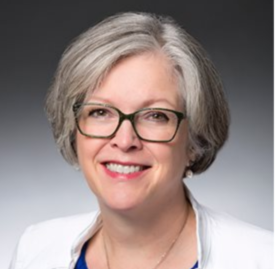
of value-based care and quality programs and regional medical director for the Gulf Coast region, has seen competition evolve over the past 3 decades in the Houston area.
To open the second half of the IVBM session, Escudier and Travis Brewer, Texas Oncology vice president of payer and public health strategy and relations, outlined how the practice has responded to the evolving landscape, including the emergence of accountable care organizations (ACOs).
Value-based care is a key ingredient to working with primary care practices, which act as the “gatekeepers” for referrals and thus must stay current with requirements for multiple health plans, Escudier said.
In the 1990s, not long after Escudier joined Texas Oncology, hospital systems began buying up physician practices in the suburbs, where many well-insured patients live. “And so over time, there was attrition…as the loyal referring doctors become part of a larger system and [were] encouraged or penalized for using or not using services and specialists employed by the same system,” Escudier said.
Then came the rise of 340B drug pricing, which allowed tax-exempt entities extend the financial advantages that were intended for underserved patients to patients in the newly acquired practices in the suburbs. “And they are able to charge hospital facilities fees as satellite clinics. It may be 30 to 50 miles from the mother ship,” Escudier said.
Texas Oncology’s offices in the Gulf Coast area “persevered,” Escudier said. From 4 small offices in 1994, they now have 27 offices and 60 physicians. “How do we do it? We provided high-quality, cost-effective care. We provide good customer service to our patients. We were able to maintain a loyal referral base by being good doctors [and] providing excellent care,” Escudier said.
Brewer then outlined other competitive elements in play. Consolidations of primary care and pharmacy providers allowed for new types of value-based
Brewer
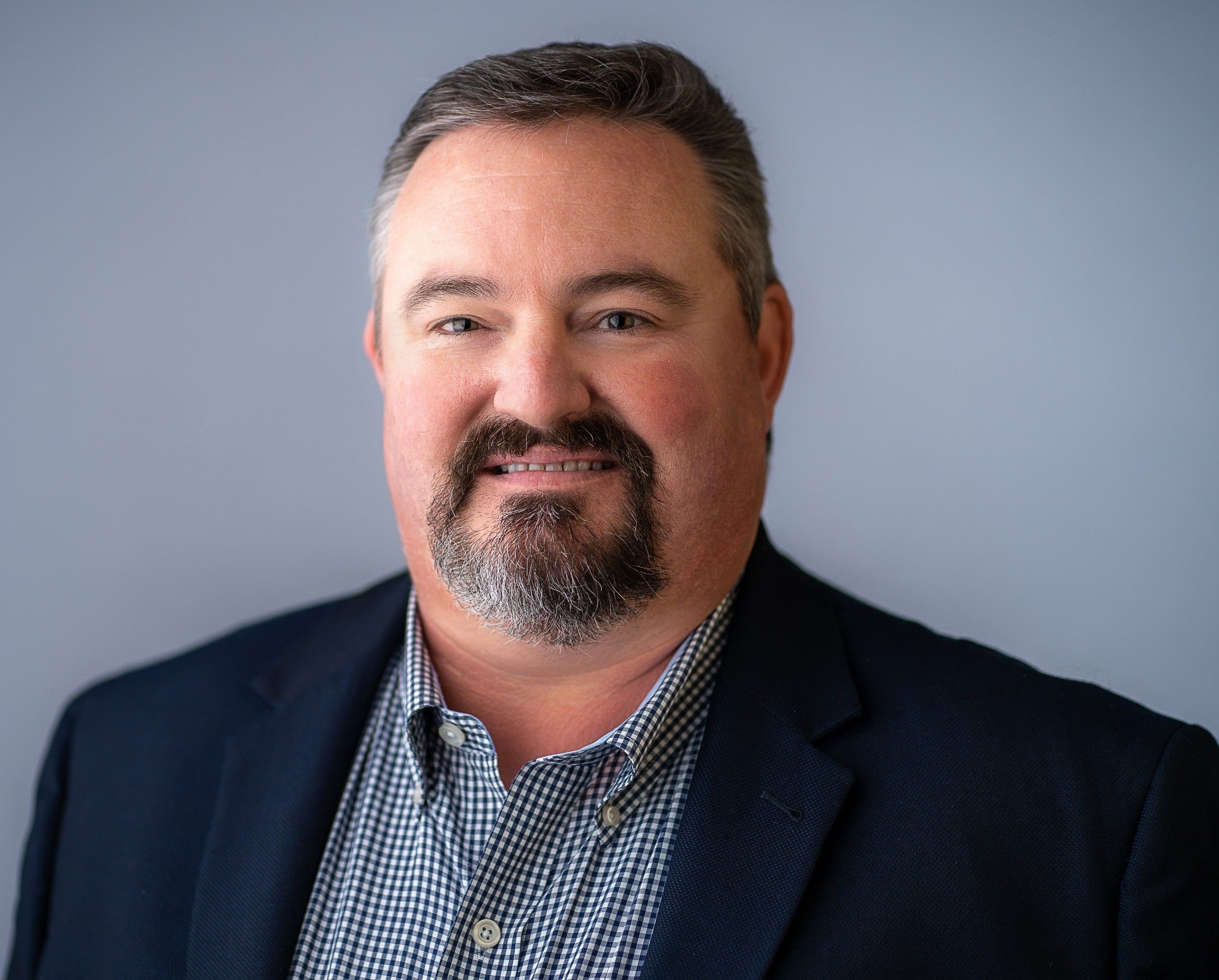
care opportunities, in which the primary care physicians could work with entities that could shoulder more risk. “If they can partner with some of these entities with deeper pockets, then they have the ability to go to self-funded employer groups and offer them value-based care contracts [with] the ability to absorb certain amounts of risk anywhere along the [value-based care] spectrum, whether it be simple pay for performance all the way up to full professional risk for the services that they provide,” Brewer said.
He listed a string of transactions that have shaped the Houston market, notably VillageMD and Walgreens, a partnership that started in Houston and has expanded nationwide. “I refer to them sometimes as the as the Amazon of health care,” Brewer said. “It’s not the CVS MinuteClinic, where you might have [a physician’s assistant] or nurse practitioner and a glorified closet in the back by the pharmacy. We’re talking 25,000- to 30,000-square-foot clinic spaces where they have MDs on staff. And it’s convenient to your local pharmacy where you may go to get your drugs, some groceries. It becomes a one-stop shop.”
Amid this disruption, how does Texas Oncology build and retain the relationships needed to spread the word on practice’s value proposition? “There’s a lot that goes into that,” Brewer said. Physician leaders and the practice’s liaison team build business relationships and network with local community leaders, such as hospital CEOs. Brewer, who previously worked for Aetna and later UnitedHealthcare, meets with payers. It often comes down to finding the right fit—a major employer with sites outside Texas might not be the best fit for a direct contract because Texas Oncology cannot serve employees in another state. But employers such as scientific groups are good candidates for this type of relationship. And Brewer explained that third-party contracting entities are emerging that can help the employer provide the necessary infrastructure.
Escudier said the “wins” are measured in different ways. Some hospital ACOs refused to include Texas Oncology in their network but have slowly approved individual physicians. VillageMD took 2 or 3 years, she said, to agree to a meaningful meeting. “It took a lot of persistence,” she said.
She added, “One of the hospital CEOs was one of the people to sort of grease the wheels, because we were doing a lot to help his hospital [and] their cancer program.” Texas Oncology asked for a referral to a large practice that uses Texas Oncology occasionally for surgical and radiation services and would like to do more. “I’m not super optimistic,” she said. “but I feel like just being in these sort of plans positions us for other things later.”
A hospital ACO that actively resisted Texas Oncology’s services has slowly allowed more of its physicians to collect performance-based payments, even though the practice as a whole is not in the top tier. “My joke was we went from active hostility to benign neglect,” Escudier said. “So, I count that as a victory.”
Moving into the Enhancing Oncology Model
The final speaker, Lalan Wilfong, MD, senior vice president of payer and care transformation at The US Oncology Network, offered an overview of EOM, first covering basic points about the model. The EOM requires practices to have at least 1 medical oncologist, is built around 6-month performance periods, and focuses on 7 common cancer types, with patients being treated with systemic therapy—not hormonal therapy. In a change from the OCM, practices will receive $70 per patient per month to provide enhanced services, down from $160 (although the EOM offers $100 for patients also eligible for Medicaid). Attribution, meaning a patient is attributed to the provider and that provider is reimbursed based on the contract, is better defined in the EOM than in the OCM. Patients are assigned to the practice that provides at least 25% of the services.9
Wilfong
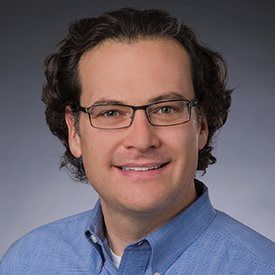
Most of Wilfong’s talk focused on 2 areas: how the EOM handles risk and the model’s emphasis on social determinants of health, or, as defined by CMS, health-related social needs.
Risk arrangements. As Wilfong explained, the EOM offers 2 downside risk options, and there is no run-in period where there is no risk. “If you go into the EOM and you screw up, you have to pay the government back,” he said bluntly.
The differences in the risk arrangements come in the area of EOM discounts, which are the points at which practices can start earning performance-based payments. As Wilfong explained, if practices achieve more savings than benchmarks in the higher risk model, they start seeing rewards if they reach savings 3% above the benchmark; in the lower-risk model, it’s at 4%. But if they fail to achieve savings, the stop-loss is 2% in the lower risk model and 6% in the higher risk model.
“The biggest difference with EOM that you’ll notice is people paying the government back at 2% below the benchmark. So it’s 98% of your benchmark; if you’re above that you have start paying the government back,” Wilfong said. “Automatically, the government is saving 2% of the total cost of care in this model. Because either you’re saving it or you’re paying them back for that 2% of the total cost of care. That’s a big difference in the model.”
Wilfong said he was not happy with this change until he realized that other models from the Center for Medicare & Medicaid Innovation, including those for primary care, incorporate this 98% payback threshold.
Health-related social needs. The requirement to report on patient needs in areas such as food, housing, and transportation goes beyond the traditional role of the oncologist, but Wilfong agrees these items contribute to care outcomes. “There have been some studies that show up to 80% of the cost of care…is due to health-related social needs,” he said.10 Patients with cancer often cannot work, and their caregivers may need to take time off as well. Anyone who is struggling financially and gets cancer will be pushed to the edge, he said.
“If you’re already having issues and you have cancer care, it’s amplified significantly,” he said, listing things such as transportation—especially with higher gas prices—or food insecurity. “And if you can’t pay your mortgage or your rent, you’re not going to have a place to live.”
Although the EOM only requires screening, Wilfong said practices in The US Oncology Network are gaining access to an app called findhelp11 that helps patients access community resources in their area that can address the major social need areas. Practices in the network will also deploy the National Comprehensive Cancer Network Distress Thermometer as a standard metric.12
Wilfong sees multiple effects from these efforts. “This will increase our patient satisfaction while reducing the burden on our practices, so that we can have efficiency; we’ll have actionable data that we can use to continue to drive improvement. And then triage the community-based organizations” so the clinic staff can work at the top of their license, he said.
He also predicts that this process will reveal deserts with limited or no community services and says the government affairs team is already engaged to respond to this problem.
All this costs money, and Wilfong cited results of a study in JAMA Internal Medicine13 suggesting the costs of addressing social needs is $60 per patient—which would consume most of CMS’ monthly payment before services such as patient navigation are even addressed.
“I can hear my finance guy: ‘You’re spending all that money—$60 of my $70—on this!’ ” Wilfong said. “But what I firmly believe is that as we start [treating] and helping patients, that not only will we help them do better with their cancer care, we will improve their outcomes, but we’ll also improve the financial performance of the practices.”
If patients stay on therapy longer and make their appointments, ultimately that’s good for the bottom line, he said. “So that’s one of the things we want to track and measure and report on in the next few years,” he said.
References
1. CMS 2023 Physician Fee Schedule final rule impacts patients and profitability. Experity. December 8, 2022. Accessed July 30, 2023. https://bit.ly/45a3N2T
2. Dyrda L. Congress keeps 2% Medicare physician pay cuts in 2023 spending bill. Becker’s Hospital Review. December 20, 2022. Accessed July 30, 2023. https://bit.ly/3DyotWz
3. After court ruling for AHA in 340B case, HHA says it will start adjusting payment rates for certain 340B hospitals within approximately two weeks. News release. American Hospital Association. October 4, 2022. Accessed July 30, 2023. https://bit.ly/3Yg33a1
4. Becker Z. PhRMA joins legal battle over Inflation Reduction Act’s ‘price-setting’ measures. FiercePharma. June 22, 2023. Accessed July 30, 2023. https://bit.ly/479aZOp
5. Brown ECF, McCuskey EY. The implications of Rutledge v PCMA for state health care cost regulation. Health Affairs. December 17, 2020. doi:10.1377/forefront.20201216.909942
6. Governor DeSantis signs most comprehensive legislation in Florida history to increase accountability and transparency for prescription drug costs. News release. Ron DeSantis 46th Governor of Florida. May 3, 2023. Accessed July 30, 2023. https://bit.ly/458Oqb0
7. Pipes S. IRA is forcing cuts to drug research. The Daily Record. May 12, 2023. Accessed July 30, 2023. https://thedailyrecord.com/2023/05/12/ira-is-forcing-cuts-to-drug-research/
8. IRA means 40% reduction in new drugs over 10 years, report finds. Bio.News. June 1, 2023. Accessed July 30, 2023. https://bit.ly/3YgfYc6
9. Enhancing Oncology Model. CMS. https://innovation.cms.gov/innovation-models/enhancing-oncology-model. Updated July 25, 2023. Accessed August 1, 2023.
10. Magnan S. Social Determinants of Health 101 for health care: five plus five. National Academy of Medicine. October 9, 2017. Accessed August 1, 2023. https://nam.edu/social-determinants-of-health-101-for-health-care-five-plus-five/
11. findhelp. Accessed July 30, 2023. https://www.findhelp.org/
12. NCCN. Clinical Practice Guidelines in Oncology. Distress management, version 2.2023. Accessed August 1, 2023. https://www.nccn.org/docs/default-source/patient-resources/nccn_distress_thermometer.pdf
13. Basu S, Berkowitz SA, Davis C, Drake C, Phillips RL, Landon BE. Estimated costs of intervening in health-related social needs detected in primary care. JAMA Intern Med. Published online May 30, 2023. doi:10.1001/jamainternmed.2023.1964
